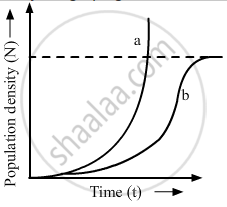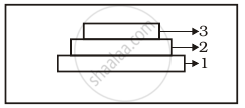Advertisements
Advertisements
प्रश्न
The number of lily plants in a pond was found to be 50. After one year, the number. increased to 65. Calculate the natality of lily plants.
उत्तर
Given that the initial number of lily plants was 50 and increased to 65 after one year, the population increase is 65 − 50 = 15 plants. The time period is 1 year. So, the calculation is:
`"Natality Rate" = "Increase in Population"/"Original Population" × "Time Period"`
`"Natality Rate" = 15/50 × 1`
`"Natality Rate" = 15/50`
`"Natality Rate" = 0.3`
This means the pond's lily plants have a natality rate of 0.3 per plant per year.
APPEARS IN
संबंधित प्रश्न
Construct an age pyramid which reflects a stable growth status of human population.
Study the graph given below and answer the questions that follow :

(i) Write the status of food and space in the curves (a) and (b).
(ii) In the absence of predators, which one of the two curves would appropriately depict the prey population?
(iii) Time has been shown on X-axis and there is a parallel dotted line above it. Give the significance of this dotted line
Define population
Answer the following question.
"The size of a population for any species is not a static parameter." Justify the statement with specific reference to fluctuations in the population density of a region in a given period of time.
The phenomenal and rapid increase of population in a short period is called ______.
The density of a population in a habitat per unit area is measured in different units. Write the unit of measurement against the following:
Bacteria
The density of a population in a habitat per unit area is measured in different units. Write the unit of measurement against the following:
Fish

Label the three tiers 1, 2, 3 given in the above age pyramid.
List any four characters that are employed in human population census.
With the help of neatly labelled diagrams, explain the different types of age pyramids of human population.
